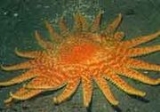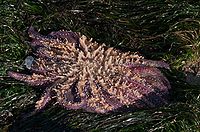
Sunflower starfish
Encyclopedia
The sunflower sea star is a large predatory
sea star
usually with 16–24 limbs called rays. It is the largest sea star in the world. Sunflower sea stars can grow to have an arm span of 1 metre (3 ft 3 in) in diameter. The color of the sunflower sea star ranges from bright orange, yellow and red to brown and sometimes to purple, with soft, velvet-textured bodies and 16–24 arms with powerful suckers. Most sea star species have a mesh-like skeleton that protects their internal organs. Easily stressed by predators such as large fish and other sea stars, they can shed arms to escape, which will grow back within a few weeks. They are preyed upon by the king crab
.
 Sunflower sea stars are quick, efficient hunters, moving at a speed of one metre per minute, using 15,000 tube feet which lie on the undersides of the body. They are commonly found around urchin
Sunflower sea stars are quick, efficient hunters, moving at a speed of one metre per minute, using 15,000 tube feet which lie on the undersides of the body. They are commonly found around urchin
barrens, as the sea urchin is a favorite food. They also eat clams, snails, abalone, sea cucumbers and other sea stars. In Monterey Bay
, California
, they will feed upon dead or dying squid
. Although the sunflower sea star can greatly extend its mouth, for larger prey, the stomach can extend outside the mouth to digest prey, such as gastropods like abalone
. Their feeding behavior was filmed for the BBC in the 2006 nature documentary Planet Earth
and again in 2009 for Life.
Predation
In ecology, predation describes a biological interaction where a predator feeds on its prey . Predators may or may not kill their prey prior to feeding on them, but the act of predation always results in the death of its prey and the eventual absorption of the prey's tissue through consumption...
sea star
Sea star
Starfish or sea stars are echinoderms belonging to the class Asteroidea. The names "starfish" and "sea star" essentially refer to members of the class Asteroidea...
usually with 16–24 limbs called rays. It is the largest sea star in the world. Sunflower sea stars can grow to have an arm span of 1 metre (3 ft 3 in) in diameter. The color of the sunflower sea star ranges from bright orange, yellow and red to brown and sometimes to purple, with soft, velvet-textured bodies and 16–24 arms with powerful suckers. Most sea star species have a mesh-like skeleton that protects their internal organs. Easily stressed by predators such as large fish and other sea stars, they can shed arms to escape, which will grow back within a few weeks. They are preyed upon by the king crab
King crab
King crabs, also called stone crabs, are a superfamily of crab-like decapod crustaceans chiefly found in cold seas. Because of their large size and the taste of their meat, many species are widely caught and sold as food, the most common being the red king crab, Paralithodes camtschaticus.King...
.
Feeding

Urchin
Urchin or urcheon is the Middle English term for "hedgehog". As such, it is applied to many things that take a similar form to a hedgehog:* Street children, homeless children who live on the street...
barrens, as the sea urchin is a favorite food. They also eat clams, snails, abalone, sea cucumbers and other sea stars. In Monterey Bay
Monterey Bay
Monterey Bay is a bay of the Pacific Ocean, along the central coast of California. The bay is south of San Francisco and San Jose, between the cities of Santa Cruz and Monterey....
, California
California
California is a state located on the West Coast of the United States. It is by far the most populous U.S. state, and the third-largest by land area...
, they will feed upon dead or dying squid
Squid
Squid are cephalopods of the order Teuthida, which comprises around 300 species. Like all other cephalopods, squid have a distinct head, bilateral symmetry, a mantle, and arms. Squid, like cuttlefish, have eight arms arranged in pairs and two, usually longer, tentacles...
. Although the sunflower sea star can greatly extend its mouth, for larger prey, the stomach can extend outside the mouth to digest prey, such as gastropods like abalone
Abalone
Abalone , from aulón, are small to very large-sized edible sea snails, marine gastropod molluscs in the family Haliotidae and the genus Haliotis...
. Their feeding behavior was filmed for the BBC in the 2006 nature documentary Planet Earth
Planet Earth (TV series)
Planet Earth is a 2006 television series produced by the BBC Natural History Unit. Five years in the making, it was the most expensive nature documentary series ever commissioned by the BBC, and also the first to be filmed in high definition...
and again in 2009 for Life.

